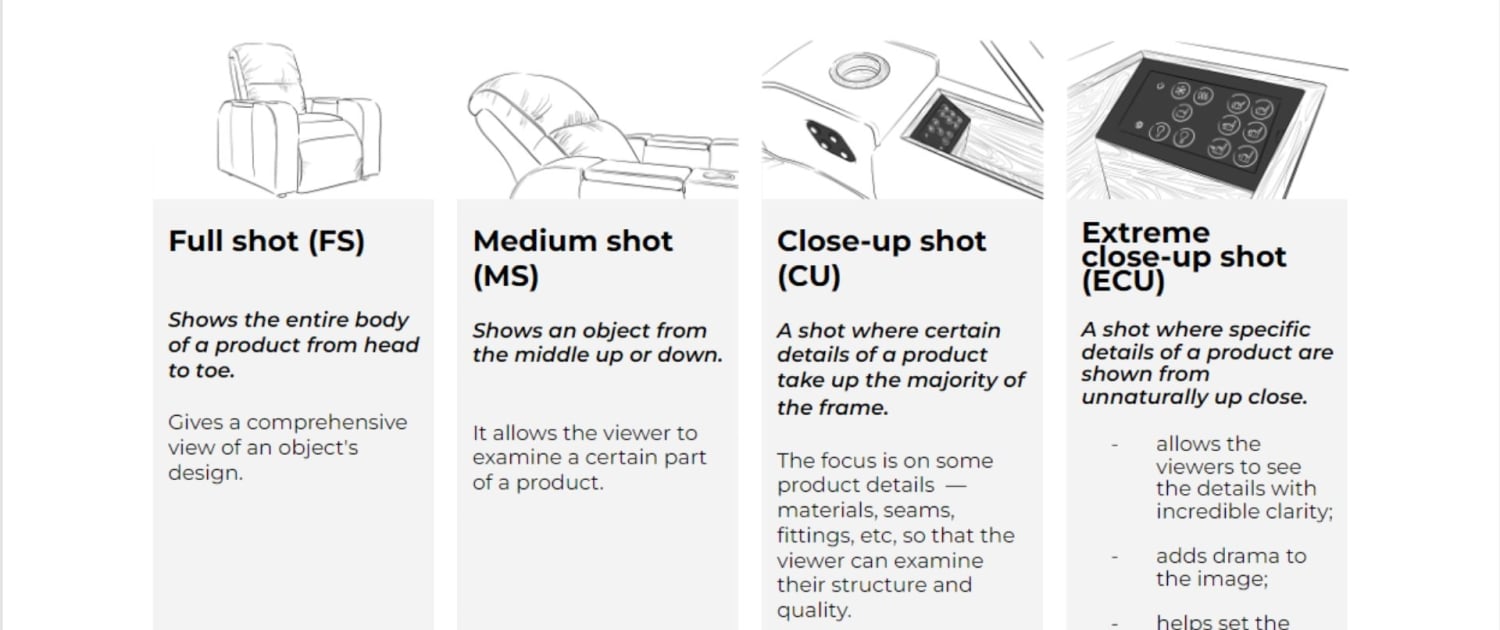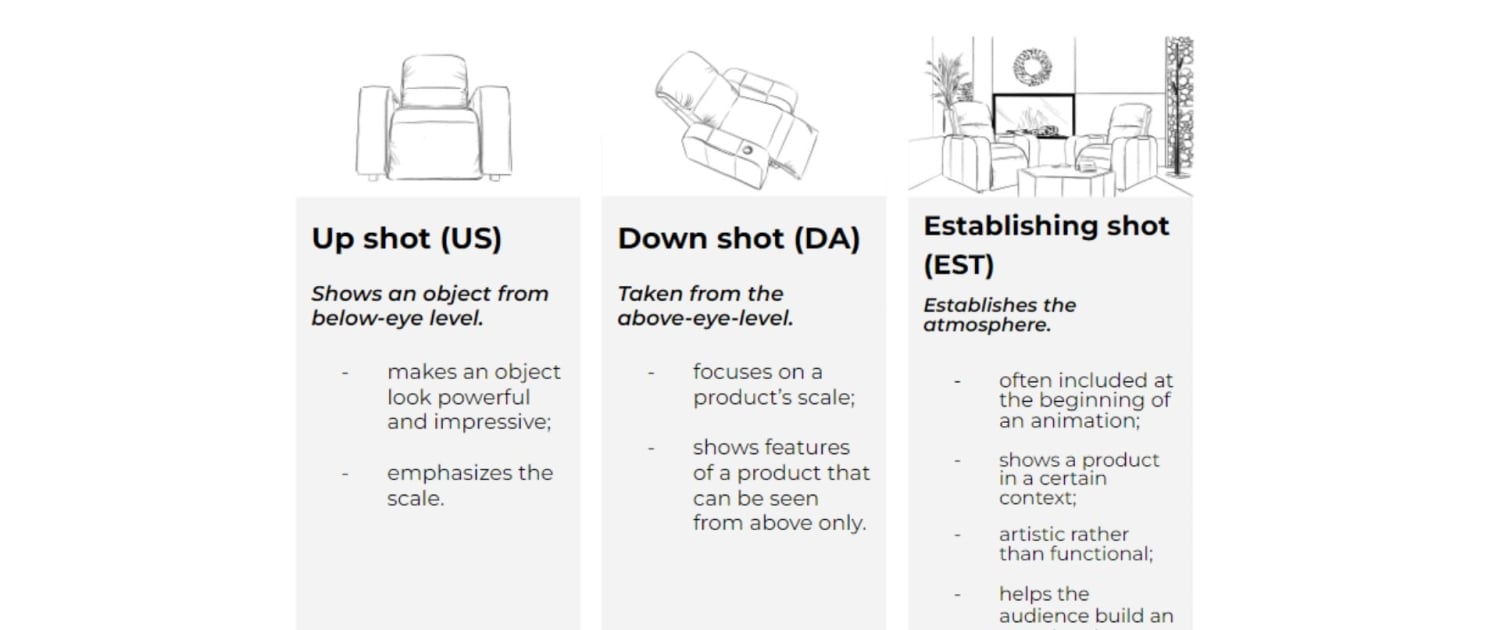The camera shots in animation are one of the most critical parts. A good shot can make an audience feel like they’re a part of what is going on on the screen, while a bad one will leave them confused and lost. The point of view you choose is essential because it dramatically impacts how your audience perceives what they see on screen.
When it comes to product videos, an outside-the-box approach to camera angles is essential to creating your unique brand communication and promo materials. One effective way to do this is by using different views for product shots, which we’ll dive into in this article.
Based on the experience of our 3D rendering company, we will cover 7 of the most used views in animation and how they can help you create excellent product presentations, promo ads, and marketing materials.
What are Camera Shots in Animation?
When selling your product or service, you want to ensure your audience sees the value you’re offering. Product 3D animation is the best way to promote your new product or service to a broad audience. Companies worldwide use 3D animations online to market their products and reach larger audiences.
Product 3D animation allows for the creation of stunningly lifelike scenes, and their use in product commercials and promotional material has become ubiquitous. Read more about 3D animated product presentations in our previous article. If you want to know more about 3D product animation ideas for marketing your brand, we also have a great overview of this topic.
Like with any video content, product animation allows you to create an immersive experience for the viewer. But how do professionals ensure that their product animations are as effective as they can be?
The answer is camera shots.
Camera shots are used to create visual variety and rhythm in videos. They allow 3D artists to use visual elements like angles, lighting, and composition to guide the viewer’s attention and ensure that a video feels dynamic and exciting.
Here are the seven camera angles most commonly used in animated product promotional material. They are worth keeping in mind when describing the concept of an animated commercial or product video for the animation studio.
#1. Full shot (FS)
The full shot (FS) is one of animation’s most common camera shots. It gives a comprehensive view of an object’s design and lets viewers see its features. This view is the most commonly used in product promotion videos.
The FS shows the entire body of a product from head to toe, which makes it great for showing off new products or concepts that need visual explanation. When you want to display your product on screen, use this type of shot so that people can see how it looks from different angles.
In some cases, full shots start an ad and show off a product before it’s used or seen in action. Most commonly, though, FSs are used at the end of ads when producers want consumers to remember what they’ve just seen.
#2. Medium shot (MS)
Camera shots in animation often indicate the setting of an environment or how things interact with their environment. The medium shot (MS) is a camera angle that shows an object from the middle up or down. This kind of shot is common for objects between six feet and infinity away from the camera. The viewer of this camera angle can easily see the whole item or main parts without seeing too much background information.
The MS is the most common and recognizable camera angle in 3D animation. It’s often used to give a sense of scale or proportion while also providing the audience with a good look at the product and essential details.
Medium shots are ideal for showing off products from different angles, and 3D artists will often use this type of camera angle to fully display a product’s intricacies.
#3. Close-up shot (CU)
The close-up shot (CU) is a camera angle where specific product details are focused. Typically, this means that the viewer can examine certain aspects of the development — materials, seams, fittings, etc. — to see their structure and quality. A CU shot is used to showcase the quality and craftsmanship of a product and can also be used to highlight individual product features that might otherwise go unnoticed.
CU camera shots in animation are often used in conjunction with other camera angles, like the full or medium shot. It can show off a product’s features and create an engaging video that makes viewers want to buy the product.
#4. Extreme close-up shot (ECU)
An extreme close-up shot (ECU) is a camera shot that shows the details of a product or an object. The ECU differs from other types of close-ups in that it allows you to see the details with incredible clarity. It adds drama and helps set the atmosphere.
ECU camera shots in animation are one of the most effective tools in product animation and commercial promo. They can be used as an artistic method to make a viewer feel involved with the product or service, straightforwardly appealing to the senses.
#5. Upshot (US)
The upshot (US) is a great option to make an object look powerful and impressive. The US is a camera angle that shows an object from below-eye level, looking up at it.
With this angle, the thing you’re filming looks powerful and impressive and emphasizes the scale of the subject. This view is often used for large items and an object’s height.
#6. Down shot (DA)
The down shot is a camera angle typically used during a commercial or marketing video to showcase a product. It shows the product’s entirety, giving viewers an idea of its size, shape, and general design.
The down shot is one of the most popular camera angles for product videos because it allows viewers to get a complete look at a product.
It is also helpful in showcasing scale—the size of the product to other things around it and the relative size compared to the person using it.
This type of shot is particularly effective when showing products typically challenging to display in real life due to size or bulkiness, such as furniture and vehicles.
#7. Establishing shot (EST)
An establishing shot (EST) is a short scene at the beginning of the animation video. It sets up the project’s location and atmosphere by showing us a context, where we are, and how the product looks.
EST camera shots in animation are often used because they can help build an emotional connection with a product. That’s why you see them in commercials all the time.
Establishing shots should be artistic rather than functional, painting a picture of what your audience wants to see rather than giving them information about your product’s specs.
The camera shots in animation are where you start to tell your brand and product story. Choosing one that best communicates your message and engages your audience is essential.
The variety of camera angles and shots used for a 3D product animation is influenced by the type of product you are animating and the client’s preference. Want to try out impressive 3D animation? Learn more about 3D product animation stages at CGIFurniture!
We add value to your project by adding motion and energy to your products with cutting-edge animation for e-commerce, marketing, corporate and advertisement purposes. From product promo materials to higher conversions, brand recognition, and loyal clients — our 3D rendering services and talented animation team can change how you approach business and marketing.
Leave a Reply
Want to join the discussion?Feel free to contribute!




I have read your blog carefully and you provided good information